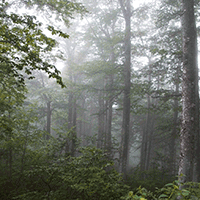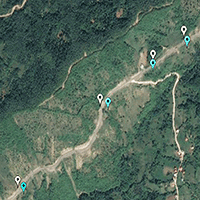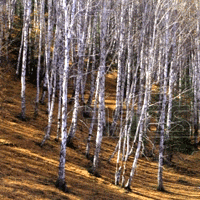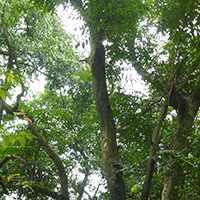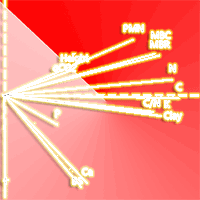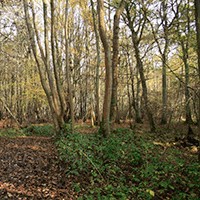A high leaf area index (LAI) can provide indications of high fertility, such as optimal health and productivity in forest ecosystem. Yet, studying the microbial biomass and inherent activity in any forest ecosystem may enable better understanding of the role of microorganisms in soil quality and nutrient cycling. This study was carried out in the western Black Sea region of Turkey with the aim to determine the influence of elevation on LAI, microbial biomass and activity in a mixed forest ecosystem. Marked differences in the LAI, light transmission, soil temperature, Corg/Ntotal ratio, and microbial properties were found at sites sampled at different elevations along an altitudinal gradient (i.e., 1200, 1300 and 1400 m a.s.l.). The LAI was statistically (P < 0.05) higher at 1300 (3.28 m2 m-2) and 1400 m (3.20 m2 m-2) elevations compared to 1200 m (2.84 m2 m-2) elevation, whereas the light transmission was statistically (P < 0.05) lower at 1300 and 1400 m elevations than that at 1200 m elevation. The amount of microbial biomass C at 1300 m (892.26 µg g-1) and 1400 m (725.99 µg g-1) elevations was significantly (P < 0.05) higher than that at 1200 m (650.84 µg g-1) elevation. Basal respiration did not vary significantly (P > 0.05) along the altitudinal gradient. An increase in respiration per unit biomass (i.e., increasing the metabolic quotient - qCO2) was also found in the sampling sites at 1200 m a.s.l. There was a positive relationship between the microbial biomass C and LAI (r = 0.612, P < 0.01) and negative relationship between the qCO2 and LAI (r = - 0.592, P < 0.01). Our results showed that the elevation gradient has a significant influence on the LAI, microbial biomass C and microbial activity in the forest stand type analyzed. A subdivision of the forest stand types into different sub-types according to their productivity and development is advisable and recommended for forest management and administration purposes.
Keywords
, , , , ,
Citation
Bolat I, Öztürk M (2016). Effects of altitudinal gradients on leaf area index, soil microbial biomass C and microbial activity in a temperate mixed forest ecosystem of Northwestern Turkey. iForest 10: 334-340. - doi: 10.3832/ifor1974-009
Academic Editor
Francesco Ripullone
Paper history
Received: Jan 07, 2016
Accepted: Jul 20, 2016
First online: Dec 15, 2016
Publication Date: Feb 28, 2017
Publication Time: 4.93 months
© SISEF - The Italian Society of Silviculture and Forest Ecology 2016
Open Access
This article is distributed under the terms of the Creative Commons Attribution-Non Commercial 4.0 International (https://creativecommons.org/licenses/by-nc/4.0/), which permits unrestricted use, distribution, and reproduction in any medium, provided you give appropriate credit to the original author(s) and the source, provide a link to the Creative Commons license, and indicate if changes were made.

Breakdown by View Type
(Waiting for server response...)
Article Usage
Total Article Views: 71855
(from publication date up to now)
Breakdown by View Type
HTML Page Views: 56575
Abstract Page Views: 10721
PDF Downloads: 3302
Citation/Reference Downloads: 60
XML Downloads: 1197
Web Metrics
Days since publication: 3288
Overall contacts: 71855
Avg. contacts per week: 152.98
Article Citations
Article citations are based on data periodically collected from the Clarivate Web of Science web site
(last update: Mar 2025)
Total number of cites (since 2017): 8
Average cites per year: 0.89
Publication Metrics
by Dimensions ©
Articles citing this article
List of the papers citing this article based on CrossRef Cited-by.
(1)
Alef K (1995)Soil respiration. In: “Methods in applied soil microbiology and biochemistry” (Alef P, Nannipieri K eds). Academic Press, London, UK, pp. 214-218.
Gscholar
(2)
Anderson JPE, Domsch KH (1989)Ratios of microbial biomass carbon to total organic carbon in arable soils. Soil Biology and Biochemistry 21: 471-479.
CrossRef |
Gscholar
(3)
Anderson TH, Domsch KH (1990)Application of eco-physiological quotients (qCO2, and qD) on microbial biomasses from soils of different cropping histories. Soil Biology and Biochemistry 22: 251-255.
CrossRef |
Gscholar
(4)
Anderson TH (2003)Microbial eco-physiological indicators to assess soil quality. Agriculture Ecosystems and Environment 98: 285-293.
CrossRef |
Gscholar
(5)
Anderson TH, Domsch KH (2010)Soil microbial biomass: the eco-physiological approach. Soil Biology and Biochemistry 42 (12): 2039-2043.
CrossRef |
Gscholar
(6)
Araujo ASF, Silva EFL, Nunes LAPL, Carneiro RFV (2010)The effect of converting tropical native savanna to
Eucalyptus grandis forest on soil microbial biomass. Land Degradation and Development 21 (6): 540-545.
CrossRef |
Gscholar
(7)
Asner GP, Scurlock JMO, Hicke JA (2003)Global synthesis of leaf area index observations: implications for ecological and remote sensing studies. Global Ecology and Biogeography 12 (3): 191-205.
CrossRef |
Gscholar
(8)
Bastida F, Zsolnay A, Hernández T, García C (2008)Past, present and future of soil quality indices: a biological perspective. Geoderma 147 (3): 159-171.
CrossRef |
Gscholar
(9)
Bauhus J, Khanna PK (1999)The significance of microbial biomass in forest soils. In: “Going underground-ecological studies in forest soils” (Rastin N, Bauhus J eds). Research Signpost, Trivandrum, India, pp. 77-110.
Online |
Gscholar
(10)
Bolat I (2014)The effect of thinning on microbial biomass C, N and basal respiration in black pine forest soils in Mudurnu, Turkey. European Journal of Forest Research 133: 131-139.
CrossRef |
Gscholar
(11)
Bouyoucos GJ (1962)Hydrometer method improved for making particle size analyses of soils. Agronomy Journal 54: 464-465.
CrossRef |
Gscholar
(12)
Breda N, Granier A (1996)Intra- and inter-annual variations of transpiration, leaf area index and radial growth of a sessile oak stand. Annals of Forest Science 53: 521-536.
CrossRef |
Gscholar
(13)
Chen JM, Cihlar J (1995)Quantifying the effect of canopy architecture on optical measurements of leaf area index using two gap size analysis methods. IEEE Transactions on Geoscience and Remote Sensing 33: 777-787.
CrossRef |
Gscholar
(14)
Coomes DA, Grubb PJ (2000)Impacts of root competition in forests and woodlands: a theoretical framework and review of experiments. Ecological Monographs 70: 171-207.
CrossRef |
Gscholar
(15)
Dignan P, Bren L (2003)Modelling light penetration edge effects for stream buffer design in mountain ash forest in southeastern Australia. Forest Ecology and Management 179: 95-106.
CrossRef |
Gscholar
(16)
Fassnacht KS, Gower ST, Norman JM, McMurtric ER (1994)A comparison of optical and direct methods for estimating foliage surface area index in forests. Agricultural and Forest Meteorology 71: 183-207.
CrossRef |
Gscholar
(17)
Fernandes SAP, Bettiol W, Cerri CC (2005)Effect of sewage sludge on microbial biomass, basal respiration, metabolic quotient and soil enzymatic activity. Applied Soil Ecology 30 (1): 65-77.
CrossRef |
Gscholar
(18)
Gower ST, Norman JM (1991)Rapid estimation of leaf area index in conifer and broad-leaf plantations. Ecology 72: 1896-1900.
CrossRef |
Gscholar
(19)
Hoff C, Rambal S (2003)An examination of the interaction between climate, soil and leaf area index in a
Quercus ilex ecosystem. Annals of Forest Science 60 (2): 153-161.
CrossRef |
Gscholar
(20)
Islam KR, Weil RR (2000)Land use effects on soil quality in a tropical forest ecosystem of Bangladesh. Agriculture, Ecosystems and Environment 79: 9-16.
CrossRef |
Gscholar
(21)
Jenkinson DS (1988)The determination of microbial biomass carbon and nitrogen in soil. In: “Advances in nitrogen cycling in agricultural ecosystems” (Wilson JR ed). CAB, Wallingford, pp. 368-386.
Gscholar
(22)
Jenkinson DS, Ladd JN (1981)Microbial biomass in soil measurement and turnover. In: “Soil biochemistry (vol. 5)” (Paul EA, Ladd JN eds). Marcel Dekker Inc, New York, USA, pp. 415-471.
Gscholar
(23)
Kitayama K, Aiba SI (2002)Ecosystem structure and productivity of tropical rain forests along altitudinal gradients with contrasting soil phosphorus pools on Mount Kinabalu, Borneo. Journal of Ecology 90 (1): 37-51.
CrossRef |
Gscholar
(24)
Lang ARG (1987)Simplified estimate of leaf area index from transmittance of the sun’s beam. Agricultural and Forest Meteorology 41: 179-186.
CrossRef |
Gscholar
(25)
Le Dantec V, Dufrene E, Saugier B (2000)Interannual and spatial variation in maximum leaf area index of temperate deciduous stands. Forest Ecology and Management 134: 71-81.
CrossRef |
Gscholar
(26)
Leuschner C, Voss S, Foetzki A, Clases Y (2006)Variation in leaf area index and stand leaf mass of European beech across gradients of soil acidity and precipitation. Plant Ecology 186: 247-258.
CrossRef |
Gscholar
(27)
Luo T, Pan Y, Ouyang H, Shi P, Luo J, Yu Z, Lu Q (2004)Leaf area index and net primary productivity along subtropical to alpine gradients in the Tibetan Plateau. Global Ecology and Biogeography 13 (4): 345-358.
CrossRef |
Gscholar
(28)
Maass JM, Vose JM, Swank WT, Martinez-Yrizar A (1995)Seasonal changes of leaf area index (Lai) in a tropical deciduous forest in west Mexico. Forest Ecology and Management 74: 171-180.
CrossRef |
Gscholar
(29)
Meier IC, Leuschner C (2008)Leaf size and leaf area index in
Fagus sylvatica forests: competing effects of precipitation, temperature, and nitrogen availability. Ecosystems 11 (5): 655-669.
CrossRef |
Gscholar
(30)
Newsome TA, Heineman JL, Linnell-Nemec AF, Comeau PG, Arsenault A, Waterhouse M (2010)Ten-year regeneration responses to varying levels of overstorey retention in two productive southern British Columbia ecosystems. Forest Ecology and Management 260: 132-145.
CrossRef |
Gscholar
(31)
Nobis M, Hunziker U (2005)Automatic thresholding for hemispherical canopy-photographs based on edge detection. Agricultural and Forest Meteorology 128: 243-25.
CrossRef |
Gscholar
(32)
Nsabimana D, Haynes RJ, Wallis FM (2004)Size, activity and catabolic diversity of the soil microbial biomass as affected by land use. Applied Soil Ecology 26: 81-92.
CrossRef |
Gscholar
(33)
Öztürk M, Bolat I (2014)Transforming
Pinus pinaster forest to recreation site: preliminary effects on LAI, some forest floor, and soil properties. Environmental Monitoring and Assessment 186 (4): 2563-2572.
CrossRef |
Gscholar
(34)
Pascual JA, Garcia C, Hernandez T, Moreno JL, Ros M (2000)Soil microbial activity as a biomarker of degradation and remediation processes. Soil Biology and Biochemistry 32 (13): 1877-1883.
CrossRef |
Gscholar
(35)
Perry DA, Oren R, Hart SC (2008)Forest Ecosystems. The Johns Hopkins University Press, Maryland, USA, pp. 606.
Online |
Gscholar
(36)
Pierce LL, Running SW (1988)Rapid estimation of coniferous forest leaf area index using a portable integrating radiometer. Ecology 69 (6): 1762-1767.
CrossRef |
Gscholar
(37)
Powlson DS, Prookes PC, Christensen BT (1987)Measurement of soil microbial biomass provides an early indication of changes in total soil organic matter due to straw incorporation. Soil Biology and Biochemistry 19 (2): 159-164.
CrossRef |
Gscholar
(38)
Rowell DL (1994)Soil science: methods and applications. Longman Publishers (Pte) Ltd, Singapore, pp. 350.
Gscholar
(39)
Schleppi P, Thimonier A, Walthert L (2011)Estimating leaf area index of mature temperate forest using regressions on site and vegetation data. Forest Ecology and Management 261: 601-610.
CrossRef |
Gscholar
(40)
Schleppi P, Conedera M, Sedivy I, Thimonier A (2007)Correcting non-linearity and slope effects in the estimation of the leaf area index of forests from hemispherical photographs. Agricultural and Forest Meteorology 144: 236-242.
CrossRef |
Gscholar
(41)
Smith L, Paul EA (1990)The significance of soil microbial biomass estimations. In: “Soil Biochemistry” (Bollag JM, Stotzky G eds). Marcel Dekker, New York, USA, pp. 357-396.
Online |
Gscholar
(42)
Spanner M, Johnson L, Miller J, McCreight R, Freemantle J, Runyon J, Gong P (1994)Remote sensing of seasonal leaf area index across the Oregon Transect. Ecological Applications 4 (2): 258-271.
CrossRef |
Gscholar
(43)
Sparling GP (1997)Soil microbial biomass, activity and nutrient cycling as indicators of soil health. In: “Biological indicators of soil health” (Pankhurst CE, Doube BM, Gupta VVSR eds). CAB International, Wallingford, UK, pp. 97-119.
Gscholar
(44)
Thornthwaite CW (1948)An approach toward a rational classification of climate. Geographical Review 38: 55-94.
CrossRef |
Gscholar
(45)
Unger M, Homeier J, Leuschner C (2013)Relationships among leaf area index, below-canopy light availability and tree diversity along a transect from tropical lowland to montane forests in NE Ecuador. Tropical Ecology 54 (1): 33-45.
Online |
Gscholar
(46)
Vance ED, Brookes PC, Jenkinson DS (1987)An extraction method for measuring soil microbial biomass C. Soil Biology and Biochemistry 19: 703-707.
CrossRef |
Gscholar
(47)
Wang XL, Jia Y, Li XG, Long RJ, Ma Q, Li FM, Song YJ (2009)Effects of land use on soil total and light fraction organic, and microbial biomass C and N in a semi-arid ecosystem of northwest China. Geoderma 153 (1): 285-290.
CrossRef |
Gscholar
(48)
Wardle DA, Ghani AA (1995)A critique of the microbial metabolic quotient (qCO
2) as a bioindicator of disturbance and ecosystem development. Soil Biology and Biochemistry 27 (12): 1601-1610.
CrossRef |
Gscholar
(49)
Yan T, Yang L, Campbell CD (2003)Microbial biomass and metabolic quotient of soils under different land use in the Three Gorges Reservoir area. Geoderma 115 (1): 129-138.
CrossRef |
Gscholar
